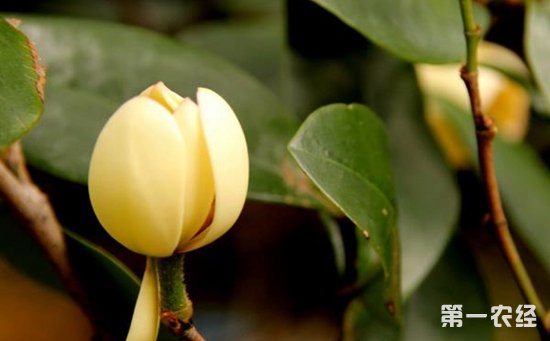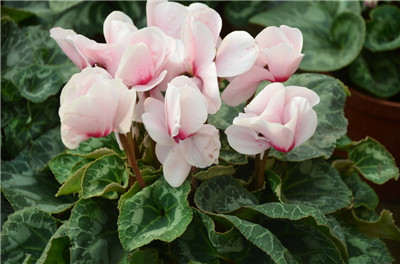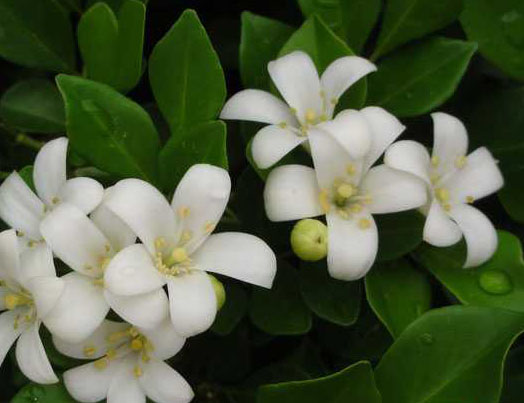How to maintain potted Michelia mollissima
Evergreen shrubs with smile. The flower is solitary in the axils of the leaves, with 6 petals, shaped like half an eggshell, milky white to milky yellow, fleshy and not fully unfolded when in full bloom. It has a strong banana-shaped aroma with a florescence of 4 ~ 6 months.
The pot soil for Michelia mollissima should be mixed with 4 rotten leaf soil, 3 garden soil, 2 compost soil and 1 sand soil. Michelia is fleshy root, stagnant water is easy to rot root, so watering should "see dry see wet". Water is watered every 1-2 days in spring and autumn, every morning and evening in summer and 5-7 days in winter. In hot, sunny, hot and dry weather, in addition to watering twice a day, it is also necessary to spray water on the leaves and wine on the ground around the flowerpot for 2 or 3 times to increase air humidity and keep the environment moist. On rainy days, we should pay attention to dumping stagnant water in the basin in time to prevent rotting roots.
Although Michelia likes fertilizer, base fertilizer has been applied in the basin soil, so it is not suitable to apply too much fertilizer during the growth period. Thin liquid fertilizer can be applied once in 10 to 15 days from the beginning of May. July to August is the period of flower bud formation, so it is appropriate to apply more phosphorus and potassium fertilizer. It is best to apply liquid fertilizer alternately with water and alum fertilizer in order to meet the nutrients needed for plant growth and to keep the basin soil acidic. Fertilization has been stopped in the north since late September.
After entering summer, it is appropriate to put the potted plants on the eastward window □ and balcony, and avoid direct sunset. Move to shade in summer or in the shade of big trees to prevent direct sunlight. Adequate light should be given in early spring, late autumn and winter to make the branches and leaves grow strong and the flowers fragrant. Smile is not hardy, the north is suitable for Cold Dew to enter the house before and after. In order to meet the needs of its growth, it is necessary to change the pot before the new leaves grow after flowering every spring, cut off the rotten roots and cut some overdense thin and weak branches, and add new culture soil.

Picture: Michelia vulgaris
1. Culture methods of Michelia mollissima in potted plants
1. Soil: Michelia is fleshy root, not resistant to dry and barren, but also afraid of stagnant water, requires good drainage, fertile slightly acidic loam, neutral soil can also adapt, can be used 4 parts of rotten leaf soil, 3 parts of garden soil, 2 parts of rotten stable fertilizer soil, 1 part of sandy soil.
two。 Watering: smile should keep the basin soil moist at ordinary times, but should never be too wet. Because many of its roots are fleshy, such as too much watering or basin waterlogging after rain, it will turn into rotten roots, so we should pay attention to controlling humidity in rainy season. Need more water during the growing period and before flowering, watering once a day, high temperature in summer should be watered to the leaf surface to maintain a certain air humidity. It can be watered once or twice a week in autumn and winter due to short sunshine.
3. Sunshine: plants with Michelia mollissima should not be exposed to the sun in summer and should be shaded by 30% so as not to burn the leaves. They can be placed indoors in windows and balconies facing east, and outdoors under shade or shade. You can see more sunshine when it is cool in autumn. Put it in the sunny ventilation place indoors in winter.
4. Temperature: the lowest temperature of Michelia mollissima overwintering is not less than 5 ℃. Once the temperature is lower than 5 ℃, the normal physiological activity of the plant will be affected, the absorption capacity of the root will be weakened, and the twigs and leaves of the plant will wilt. At the same time, the highest temperature should not exceed 15 ℃. If the temperature is too high, too much nutrients are consumed in the plant, which is disadvantageous to the growth of the next year. Therefore, it is suitable to keep the room temperature at 5 ℃ to 15 ℃ in winter.
Picture: Michelia vulgaris
5. Fertilization: Michelia flowers like fertilizer, often use rotten cake fertilizer, bone meal, chicken and duck manure and fish belly intestines and other retting fertilizer mixed with water, apply fertilizer every 15 days in the growing season (April-September), and stop fertilization after flowering and October. If you find that the leaf color is not bright and thick green, you can apply fertilizer and water for once.
6. Insect pests: shell insects often occur in Michelia, and can also induce soot disease, which can be brushed off with a small brush or sprayed with No. 20 petroleum emulsion with 150x water. Soot disease can be prevented by scrubbing with clean water or spraying with carbendazim aqueous solution 1000 times of water.
7. Pruning: Michelia flowers should not be overpruned. Usually, the overgrown branches, weak branches and overdense overlapping branches that affect the tree shape can be pruned after flowering, and the fruit after flowering can be subtracted to reduce nutrient consumption. Before sprouting in spring, remove some old leaves properly to trigger new branches and leaves.
8. Turn the pot: Michelia flowers turn the pot every 1-2 years, preferably before the new leaves are released in spring, or after flowering, or in autumn. Combined with changing the basin to remove some of the old soil, replace it with fertile and loose soil, subtract withered branches and overgrown roots, and place sufficient base fertilizer in the basin.
Picture: Michelia vulgaris
Matters needing attention in pot culture of Michelia mollissima
Michelia mollissima has thick roots and is not resistant to transplantation. it is appropriate to bring more soil balls and properly cut branches and leaves when transplanting. If soil balls are loose during transplanting, branches and leaves must be re-cut in time, otherwise the whole plant is easy to die; Michelia mollissima is not resistant to early drying, scabies, fear of waterlogging, like fertile, loose, well-drained micro-acid loam; Michelia plants should be properly ventilated and transparent during winter, so as to avoid the harm of aphids, shell insects and other pests. Watering Michelia flowers should be carried out when the temperature is high at noon and maintain appropriate humidity in the greenhouse; if no seeds are left after Michelia mollissima flowers, the young fruits should be cut off in time to reduce nutrient consumption.
[editor's conclusion] Michelia mollissima is conducive to growth in a weak overcast environment, avoiding bright light, and special attention should be paid to it in the process of maintenance. The above introduces the cultivation methods and matters needing attention of potted Michelia mollissima. I hope it can be helpful to you!
- Prev

What are the benefits of raising cyclamen at home?
Cyclamen can not only decorate the environment and beautify the home, but also purify the air. It is a rare indoor potted plant. Moreover, the proportion of cyclamen cultivated in soilless culture has greatly increased in recent years. This kind of cyclamen is clean and beautiful, and is welcomed by the majority of flower lovers. 1. Beautify the environment
- Next

What are the main measures to make Jiuli fragrant flowers numerous and fragrant?
Jiuli incense is known as Qianli incense and moon tangerine. For evergreen shrub or little Joe. Small Cymes terminal or axillary, white, strong fragrance, strong diffusivity, flowering in autumn. In order to make it fragrant, potted plants should choose sandy soil rich in humus and loose and fertile. Change the second basin in the early spring every year in the young tree period.
Related
- Fuxing push coffee new agricultural production and marketing class: lack of small-scale processing plants
- Jujube rice field leisure farm deep ploughing Yilan for five years to create a space for organic food and play
- Nongyu Farm-A trial of organic papaya for brave women with advanced technology
- Four points for attention in the prevention and control of diseases and insect pests of edible fungi
- How to add nutrient solution to Edible Fungi
- Is there any good way to control edible fungus mites?
- Open Inoculation Technology of Edible Fungi
- Is there any clever way to use fertilizer for edible fungus in winter?
- What agents are used to kill the pathogens of edible fungi in the mushroom shed?
- Rapid drying of Edible Fungi

